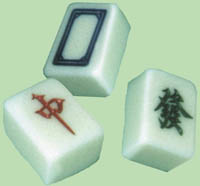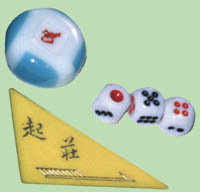 Online
Edition
Online
Edition | From
the editor Letters to the editor Milestone Answerman Periscope Campus Life Social Issues People Photo Features Education Channel Culture & Leisure Science |
| Last
Issue Archive |
| About
Varsity Advertise Media Links CUHK homepage JLM homepage |
Also
in Culture and Leisure
Urban art
Related Links
Department
of Anthropology of CUHK
Department of Sociology of HKBU

![]()
![]()
![]()
![]()
![]()
![]()
![]()

The game
of mahjong - therapy and cultural heritage
By Sam Ho
 Mahjong is not a new game in Chinese society. Despite the amusement provided
by the game, not many people know about its therapeutic effects and history.
Mahjong is not a new game in Chinese society. Despite the amusement provided
by the game, not many people know about its therapeutic effects and history.
At the Geriatric Day Hospital of Shatin Hospital, one of the rehabilitation hospitals in Hong Kong, mahjong is a kind of therapy rather than a game. Mahjong therapy was adopted in 1993.
Daphne Law is an occupational therapist at Shatin Hospital.
Miss Law said playing mahjong is an effective therapy for patients experiencing dementia or depression or who have had a stroke.
"Playing mahjong can improve the motor functions, cognitive functions and the psychological interaction of patients, especially the elderly," said Miss Law.
Regarding motor functions, she said mahjong can train patients' eye-hand coordination.
As for cognitive functions, it trains patients' organisational ability and attentiveness. It can also improve social skills of depressed patients.
Said Miss Law: "When a patient wins, he has a sense of achievement, which encourages ongoing participation.
"The game can distract patients from pain. Patients are more likely to accept this therapy."
Receiving ongoing feedback from other patients during the game also improves patients' health.
Miss Janet Chong is an occupational therapist at Shatin Hospital.
"The game really encourages motor and sensory responses," said she.
A stroke patient said that the mahjong therapy was helpful.
"I really do more arm exercises than before. The movement of my arm has smoothened and it soothes my pain," he said.
Mahjong therapy is applied in many rehabilitation hospitals in Hong Kong.
Despite its therapeutic effects, mahjong is sometimes considered a form of gambling and is thus not encouraged.
But Prof. Maria Tam, an associate professor in the Department of Anthropology at The Chinese University of Hong Kong, disagrees.
Said she: "Using money as a bet in the game is optional.
"I know there are mahjong clubs or classes teaching students to play mahjong in some international schools in Hong Kong."
According to Prof. Tam, betting money is due to the belief that there should be rewards to winners.
Prof. Chiu Yin Leung of the Department of Sociology at Hong Kong Baptist University said that playing mahjong does not have any social impact because it is just a leisure activity and involves little money.
However, Prof. Tam disagreed.
She said, "The institutionalisation of mahjong in the social system is significant. The game has become a part of social life and Chinese culture.
"That means people prefer playing mahjong with friends or relatives because it is a cultural heritage."
She said that the game functions as a signifier of Chinese culture and tradition.
At many family gatherings or Chinese wedding banquets, mahjong is part of the programme.
A manager at Hon Kung Restaurant in Mong Kok said that nearly half of his clients play mahjong at wedding banquets and birthday banquets.
Regarding student gatherings, about one-fifth of them play mahjong, he said.
Said Prof. Tam: "Therefore, it somehow strengthens the bond and the sense of belonging among the Chinese in the world.
"I feel positive about this game." As a cultural heritage, many people may not know the origin of the game.
Throughout history many theories have been presented regarding its invention.
One theory suggests that Confucius, the great Chinese philosopher, developed the game in 500 B.C.
Historians suggest that it developed further during the Spring and Autumn period, which was before the Qin Dynasty.
Prof. Tam said that there are no official historical records of the existence of the game of mahjong.
"So, like fables, it is hard to tell when and how the game was invented," said Prof. Tam. "Maybe it just came in suddenly as a fashion."
But the most compelling theory suggests that the game was developed from various other Chinese games.
The rules for playing mahjong vary from place to place.
For example, there are differences between ways of playing mahjong in Taiwan and Hong Kong.
 "Such differences in rules reflect the public conception of a social
system in a particular society,"
"Such differences in rules reflect the public conception of a social
system in a particular society,"
Prof. Tam said. Prof. Tam said that the game itself also changes from time to time, with new rules arising.
Said Prof. Tam: "The format for playing mahjong nowadays is entirely
different from the original form." ![]()

![]()
![]()
![]()
![]()
![]()
![]()
![]()

![]() How to
play mahjong
How to
play mahjong
Mahjong is played with 144 domino-like tiles.
The tiles have patterns of bamboo, dots, Chinese characters and eight flowers. Aside from these, there are four winds, known as East, South, West and North.
There are also special honour pieces namely Red Dragon, Green Dragon and White Dragon, or simply Red, Green and White.
Four players, designated East, South, West and North, each build a wall of 18 tiles long and two tiles tall. Then they position them to form a hollow centered "wall".
Three dice are thrown by the East player to determine which wall is to be broken.
Each player then draws four tiles from the left of the opening of the wall at a time until they get 12 tiles each. Then each player takes turn to draw one more tile to make 13 tiles. The East player draws two more tiles instead of one to make it 14.
The players then take turns drawing one tile each and discarding one.
Extra credits can be added with sequences called "chowing" or![]() "pung".
"pung".
![]()